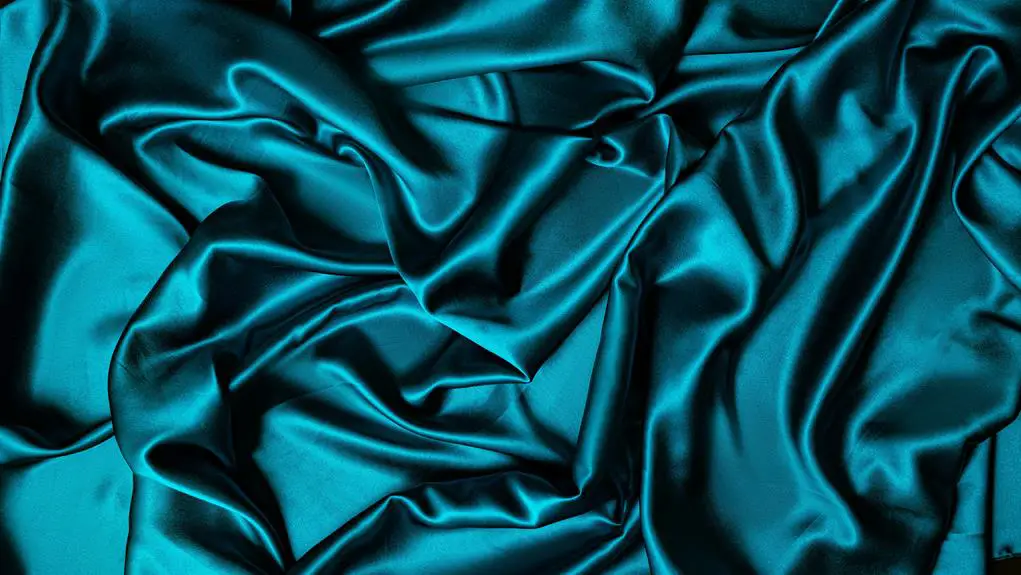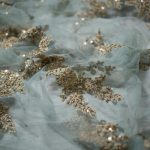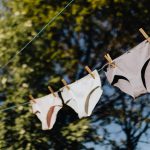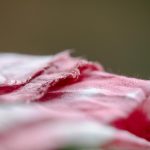When you're considering gossamer fabric for your next project, you'll notice its exceptional drape truly sets it apart from heavier materials. Its delicate, flowing nature creates an ethereal quality that adds depth and movement to any garment. This unique fluidity invites you to explore how it enhances not just the silhouette but also the overall aesthetic of your design. However, the characteristics that make gossamer so captivating also introduce challenges you might not expect. What techniques can you employ to work effectively with this versatile fabric?
Table of Contents
Characteristics of Gossamer Fabric
What makes gossamer fabric stand out is its incredibly lightweight and sheer quality, giving it an ethereal feel that's perfect for elegant garments and delicate drapery.
This fabric is often made from silk, cotton, or synthetic fibers, which enhances its gentle texture and flow. When you touch gossamer, you'll immediately notice its smoothness, contributing to a soft and alluring drape that floats beautifully with every movement.
You'll find that gossamer possesses a remarkable transparency, allowing light to filter through in an enchanting way.
This trait makes it ideal for layering or creating stunning overlays, enhancing any design. Its breathability ensures that it remains comfortable even in warmer conditions, making it a favorite for summer wear and events.
Additionally, gossamer's inherent flexibility allows it to take on various shapes and forms, enabling you to experiment with styles.
Although delicate, it holds up well with appropriate care. You'll appreciate its versatility, as it works seamlessly for everything from romantic dresses to elegant curtains.
With gossamer in your wardrobe or decor, you're sure to add a touch of whimsy and sophistication.
Comparing Gossamer to Other Fabrics
When you compare gossamer to silk, you'll notice some key differences in drape and weight.
Gossamer's lightness gives it a unique fluidity that sets it apart from heavier fabrics.
Understanding these distinctions can help you choose the right fabric for your project.
Gossamer Vs. Silk Drape
Gossamer drape offers a unique ethereal quality that sets it apart from silk, making it an appealing choice for lightweight, delicate applications. While silk also provides a luxurious feel, Gossamer tends to create a more sheer and airy effect that can enhance a garment's overall movement and fluidity.
When you're working with Gossamer, you'll notice its delicate structure allows for a billowing drape that floats gracefully around the body. This contrasts with silk, which, though it has a beautiful luster and smoothness, often leans towards a heavier drape that provides more structure. If you're designing for a flowing gown or whimsical overlays, Gossamer's softness and lightness can elevate your creations.
Furthermore, Gossamer's subtle translucence can lend an enchanting, layered effect, especially when combined with other fabrics. In contrast, silk's opacity might ground a design, leading to a more classic look. Ultimately, your choice between Gossamer and silk depends on the specific visual and tactile experience you're aiming for, but these distinct draping characteristics will guide your decision.
Weight Impact on Drape
The weight of a fabric significantly influences its drape, and Gossamer's lightweight nature creates a dramatically different flow compared to heavier materials. When you drape Gossamer, you'll notice how it cascades and moves effortlessly, enhancing the overall elegance of your designs. This fluidity stands in stark contrast to fabrics like cotton or denim, which can feel stiff and restrict movement.
Heavier fabrics often require more structure and support, making them less versatile in terms of drape. You might find that while these materials create a sculptural effect, they lack the ethereal quality Gossamer offers. In garments, this means Gossamer can produce soft, delicate lines that flatter the wearer's silhouette without adding bulk.
When evaluating drape, consider how Gossamer will perform in layering. The lightweight fabric allows for seamless mixing with other materials, contributing to a more dynamic look. So, if you're seeking a fabric that embodies grace without compromising on structure, Gossamer's lightness can elevate your creations far beyond what heavier fabrics can provide.
Your designs will have movement and life, showcasing Gossamer's unique attributes beautifully.
Gossamer's Flow and Movement
Experiencing gossamer's flow and movement reveals a delicate dance that captivates the senses. When you drape this lightweight fabric, you'll notice how it glides effortlessly, creating a feeling of ethereality that draws the eye. Gossamer moves with you, embracing your motions and enhancing every gesture.
Here's a glimpse into how its flow can be perceived:
| Aspect | Emotion Evoked | Visual Representation |
|---|---|---|
| Softness | Serenity |  |
| Fluidity | Grace |  |
| Transparency | Intrigue |  |
| Lightness | Freedom |  |
You can't help but feel how gossamer captures light and air, adding life to your creations. Its ability to flutter gently when touched evokes a sense of whimsy and playfulness. As you explore this fabric's potential, you'll find that its nuances enhance your design, making each moment spent with gossamer a unique experience.
Techniques for Working With Gossamer
When you're working with gossamer, understanding its unique fabric characteristics is key to achieving the perfect drape.
You'll need to master cutting and stitching methods tailored to this delicate material to ensure clean, crisp lines.
Plus, having the right tools on hand can make all the difference in your results.
Fabric Characteristics and Drape
Gossamer fabrics are known for their lightweight and sheer qualities, requiring careful handling to achieve optimal drape and performance. When you work with gossamer, understanding its unique characteristics is essential to ensure beautiful results.
To help you navigate the challenges of gossamer, consider these key aspects:
- Lightweight Nature: Gossamer's delicate weight allows for incredible flow and movement but can also lead to unintentional shifts during cutting or sewing.
- Sheerness: Its transparent qualities mean that you'll want to pay extra attention to the layers and linings you choose, as they'll influence the overall appearance.
- Fluidity: Gossamer drapes beautifully, adding a soft elegance to your designs, but it can also be tricky to control. Careful pinning or weight distribution can minimize this.
Cutting and Stitching Methods
Cutting and stitching gossamer requires precision and care to maintain its delicate structure and avoid fraying.
When you're ready to cut, lay the fabric flat on a clean, sharp surface. Use straight, measured-cutting techniques and sharp fabric scissors to ensure a clean edge. A rotary cutter can also be effective for straight lines, but practice caution to avoid snagging.
Next, consider your stitching method. Gossamer's thin nature calls for lightweight threads, so opt for fine threads that match the fabric and blend seamlessly. When you're sewing, employ a straight stitch or a zigzag stitch to provide enough flexibility while keeping the seams secure. Short, consistent stitch lengths help distribute tension evenly along the seam.
Don't forget to use a needle appropriate for lightweight fabrics; a microtex or universal needle works best. To prevent fraying, finish your edges with a narrow, serged seam or a French seam, which encloses the raw edges.
Lastly, always test your techniques on scrap pieces of gossamer first to refine your approach and ensure your finished product maintains its beautiful drape.
Recommended Tools and Techniques
To achieve the best results with gossamer, you'll want to equip yourself with specific tools and techniques designed for its delicate nature. Working with gossamer can be tricky, but having the right tools in your arsenal will make the process smoother and more enjoyable.
Here are some recommended tools and techniques to consider:
- Micro-tip scissors: These allow for precise cutting without snagging the fabric.
- Lightweight pins: Use ballpoint or fine pins to avoid damaging the fibers while keeping your pieces aligned.
- Clear tape or fabric glue: For securing delicate seams temporarily, these can help prevent shifting while you sew.
When working with gossamer, practice patience. Pre-wash and air dry to minimize shrinkage, and always handle the fabric gently to avoid pulling or tearing.
Adopting these tools and techniques will help you create stunning projects that showcase gossamer's beautifully draped qualities!
Application in Fashion Design
When you explore fashion design, the delicate allure of gossamer drapes transforms garments into ethereal statements that float with movement. This incredibly lightweight fabric lends itself to creating dresses, blouses, and overlays that evoke a sense of grace and elegance. Gossamer can be layered to add depth without overwhelming your design, allowing you to experiment with silhouettes that seem almost weightless.
When working with gossamer, consider the layering techniques for maximum effect. You can drape it over solid fabrics to introduce a soft contrast that enhances your design's overall appeal. Don't shy away from combining gossamer with other materials; it beautifully complements silk and chiffon, creating visual interest and textural variety.
Incorporating gossamer into your collection allows you to explore whimsy and fantasy, perfect for evening wear or bridal designs. Remember, gossamer isn't just for clothing—its sheer aesthetic can enhance accessories, like scarves and shawls, ensuring your entire look exudes a dreamy vibe.
Care and Maintenance Tips
Caring for gossamer fabric involves handling it with gentle attention, ensuring its delicate beauty lasts longer. Since gossamer is lightweight and sheer, you'll want to be careful throughout the cleaning and storage process. Here are some helpful tips to keep in mind:
Wash by Hand: Use cold water and a mild detergent when washing your gossamer items. Avoid using a washing machine to prevent snagging and tearing.
Air Dry: Gently squeeze out excess water and lay the fabric flat on a clean towel to dry. Avoid wringing or twisting it, which can distort its structure.
Store Properly: When not in use, store gossamer in a cool, dry place. Avoid hanging it on hangers, as this can stretch the fabric. Instead, fold it neatly and place it in a drawer or on a shelf.
Avoid Heat and Sunlight: Keep gossamer away from direct sunlight and heat sources, which can weaken the fibers over time and lead to discoloration.
Frequently Asked Questions
Is Gossamer Fabric Suitable for Activewear Clothing?
You might find gossamer fabric too delicate for activewear. Its lightweight nature can impede durability and support, which are essential for rigorous activities. Consider more robust materials that provide better performance for your active lifestyle instead.
What Weight of Gossamer Is Best for Evening Gowns?
For evening gowns, you'll want a gossamer fabric weighing between 2 to 4 ounces. This weight provides sufficient elegance and flow while ensuring the gown maintains a luxurious appeal without overwhelming your silhouette.
Can Gossamer Be Layered Without Losing Its Drape?
Yes, you can layer gossamer without losing its drape. When you choose compatible weights, the fabric maintains its flow and elegance, enhancing your design's overall appearance while adding depth and texture for a stunning effect.
How Does Humidity Affect the Drape of Gossamer Fabric?
Humidity can significantly affect how gossamer drapes. High moisture levels may cause the fabric to feel heavier, leading to less fluid movement. In contrast, low humidity helps maintain its light, airy drape. Keep this in mind!
Are There Specific Colors That Enhance Gossamer's Draping Qualities?
Certain colors can enhance gossamer's draping qualities. Lighter shades often create a more ethereal look, while darker hues can add depth and richness, making the fabric flow beautifully and accentuating its delicate nature when worn.
- How Does Ring Spun Cotton Affect Garment Fit and Shape Retention? - August 13, 2024
- What Are the Challenges in Producing Ring Spun Cotton? - August 13, 2024
- Is Ring Spun Cotton Suitable for Plus-Size Clothing? - August 13, 2024







